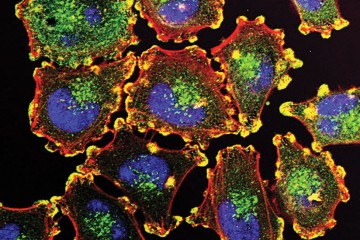In a sample study, researchers at Johns Hopkins say they have found an association between the makeup of an individual's microbiome and head and neck cancer, a finding that potentially advances the quest for faster and more accurate cancer diagnosis and therapy.
In a report on the research published on May 30 in Oncotarget, the scientists say that populations of the human microbiome—the collection of normal bacteria inhabiting people's bodies—can help discriminate between patients with head and neck cancer and healthy individuals.
"One of the goals of our research is to better understand how the microbiome may influence the immune response to cancer and how the immune response affects the microbiome in turn," says Rafael Guerrero-Preston, assistant professor of otolaryngology–head and neck surgery at the Johns Hopkins University School of Medicine. "Our findings suggest that we may one day use the composition of the microbiome to test for disease."
Trillions of microbes colonize the adult body. Changes in this community have already been tied to the risk and presence of arthritis, multiple sclerosis, irritable bowel syndrome, and cancer. With more information on how these microbes are connected with cancer and cancer risk factors—such as genetic predispositions, smoking, and other environmental factors—researchers hope to create individualized screening and treatment plans for cancer patients and for those at an increased cancer risk.
For this study, Guerrero-Preston and his colleagues extracted bacterial DNA from the saliva of 42 patients. Seventeen samples were drawn from people with head and neck squamous cell carcinoma, seven of which were positive for HPV and 10 of which were HPV-negative. Twenty-five noncancerous samples were used as a control.
The bacterial DNA found in the saliva was sequenced and sorted into groups of highly related populations. Through further DNA analysis, researchers were then able to determine the category, or genus, of bacteria to which each group belonged.
The researchers found differences in the bacterial populations present in cancerous versus noncancerous samples. Samples from patients with tumors, for example, showed increased populations of Streptococcus, Dialister, and Veillonella genera, as well as decreased populations of Neisseria, Aggregatibacter, Haemophilus, and Leptotrichia genera with respect to controls. Tumor samples also showed an increased prevalence of the Lactobacillus genus, which was present in 9.1 percent of tumor samples and in only 0.1 percent of the healthy controls.
In addition, the researchers found correlations between the types of bacteria present and the patients' HPV statuses. HPV-positive samples had increased abundances of Gemellaceae, Leuconostoc, and Veillonella genera when compared to HPV-negative samples. Veillonella, for example, was present in 15 percent of HPV-positive tumor samples but was only present in 9.4 percent of HPV-negative tumor samples.
"We see some specific bacterial populations that are increased or lost in the presence of cancer when compared to healthy controls," Guerrero-Preston says. This may mean that either the tumor is affecting the environment in the mouth by killing bacteria that would fight cancer or that the patients may be predisposed to cancer because they originally lacked bacteria that prevent tumor development.
Guerrero-Preston cautions that these findings do not establish a direct cause-and-effect link between any of the bacteria and head and neck cancer, stressing their preliminary nature. In particular, he says, future research needs to distinguish between the detection of bacterial DNA and the effects of the bacteria themselves. In order to determine how bacteria affect the oral environment, Guerrero-Preston's team intends to look at which genes bacteria have turned on in saliva samples.
If the differences in the microbiome between cancerous and noncancerous patients are confirmed in further studies, doctors may be able to use the same sequencing tools as Guerrero-Preston to quickly and accurately screen and diagnose patients based on the bacteria present in their mouths.
Read more from Hopkins MedicinePosted in Health, Science+Technology
Tagged cancer, otolaryngology, immunology, immunotherapy










